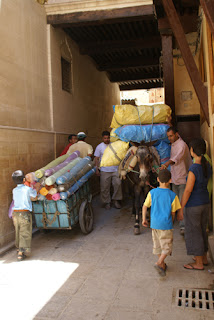
We’d heard from a few travellers along the way that
Morocco is a bit of a shock to the system. We’d listened to these various stories passively, thinking perhaps these people were of the sort who thought staying at a hotel without a pool and a Starbucks downstairs was roughing it. Us? We thought we were pretty hardcore travellers – we’d been to a Muslim country before, trekked through dangerous jungles, survived cold water showers and dodgy food, fought off thousands of touts and dodged millions of donkey poos. How hard could it be? As it turned out,
Morocco really was the most completely chaotic and crazy place we’ve been to, a fact which doesn’t quite translate in the photos. We met so many incredibly friendly people but also some of the dodgiest. The Moroccan tagines, kebabs and couscous were amazing but also gave us gastro the whole time we were there. There are some Moroccans with incredible wealth but poverty is everywhere on the streets and cheating tourists is pretty much an accepted practice in order to keep your family fed. The streets are filthy but the people take great pains to be completely clean at least once weekly as part of their Islamic tradition (literally, scouring their entire epidermal layer off – more on this later).
We caught a ferry across the Straits of Gibraltar from the southern coast of Spain to arrive in Tangier on the northern coast of Morocco. It was interesting that a 45 minute ferry ride could take you from Europe into Africa. Stranger still was the passport control into Morocco which we found was a couple of Moroccan guys in T-shirts sitting at one of the tables in the ferry cafeteria smoking casually while stamping out visas. The Lonely Planet Morocco gives the impression that foreigners landing on the shores of Tangier will inevitably be confronted with a ruthless mob of money-hungry touts capable of tearing you to shreds. People on tripadvisor.com had posted horror stories and comments like “Get out of Tangier ASAP!” We had mapped out our strategy on the ferry: no eye contact, walk straight and fast, and pretend not to speak English (if pressed, claim to be Mongolian students). So it was mildly anticlimactic to disembark and find only two disinterested taxi drivers waiting at portside. In fact, our taxi driver was so friendly he took us to the train station for free because he didn’t have change for our 100 dirham note.
On the train to Fes we encountered the apparently trademark Moroccan gregariousness. Locals hopping on and off the train struck up conversations with us and each other about the best bug sprays, where they were born, which was the best town in the country etc and the atmosphere soon became akin to a little cabin party. The girl in the corner gave half her sandwich to the woman next to Vicky who then gave Vicky a friendly slap and squeeze on the thigh. People taught us Arabic words and we met a man who exclaimed “That’s my friend!” while pointing to the shepherd on the cover of the Lonely Planet Limmy was reading.
The medina of Fes is a labyrinth of 9600 narrow meandering streets, a handful of which are signed in Arabic. Almost every street looks the same. Houses, shops, butchers (with bunches of live chickens bound by their feet, and strung-up camel heads destined for soups), beggars, grubby kids running everywhere, real estate agents, spice shops, donkeys with huge loads, cartfuls of oranges, all crammed into the same space. Melbourne has 18 people per hectare. London, 47. Kuala Lumpur, 78. Fes medina has 550. Houses stacked on houses stacked on shops. No cars are allowed in the streets; the only permitted transport is donkey. They will never expand the medina outwards because it is bounded on all sides by Muslim graves. It took us 40 minutes in 40 degree heat walking with a combined 40 kg of backpack, to locate our guesthouse even though it turned out we’d been dropped off less than 100 metres from its door. One of the guys we met on the train had hooked us up with a guide to take us around the medina which probably saved us lots of time trying to find our way around. He took us to a hill overlooking the medina so we could appreciate the chaos from above.

Fes from above. The neighbouring suburbs.
The neighbouring suburbs.
Limmy, sheep and derelict building.

Traffic jam in Fes.

Fes real estate agents.

Outside the medina.

"Waiter? I feel like a little beer."
The following day we ploughed into the medina on our tour. We saw the mosque, the world’s first university (est. 859 AD), the wood museum, the woodcraft shop, the carpet shop, and after lunch, the tannery (and leather shop), the traditional pharmacy (a.k.a. herb shop), and the silk shop. Moroccans are some of the hardest sellers in the world. The carpet guy suggested that buying several $2000+ plus carpets and re-selling them back home for a ten-fold profit was the perfect way to recoup travel expenses. We kept a pretty safe distance from the tanneries. They use pigeon droppings and camel urine to soften the skins – ugh! The one sour note was our guide who was pretty shifty and seemed upset at not earning any commission from us since we didn’t buy anything from the shops. So we were somewhat relieved when the tour ended (not without bickering over payment) and we were able to get out of the dirty streets and 40 degree heat and back to our lovely riad.
 The tannery. If only you could smell it.
The tannery. If only you could smell it. "Hello, Fatima!"
"Hello, Fatima!"
 Look how he loves his food!
Look how he loves his food!
 Breakfast at the riad.
Breakfast at the riad.












No comments:
Post a Comment